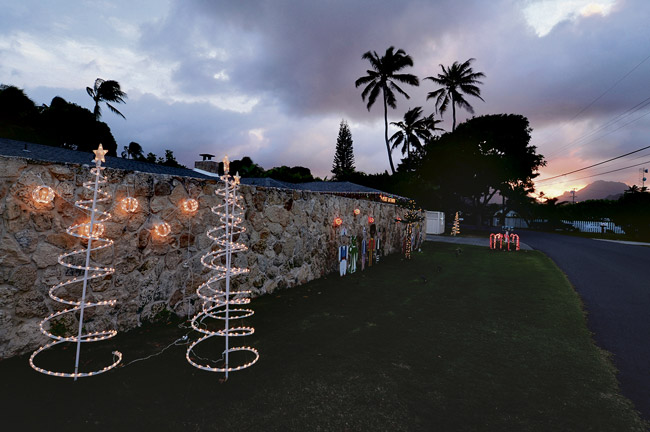Electricity Bills: Bah! Humbug!

LED Christmas lights can save a bundle on electricity compared to traditional bulbs. Nathalie Walker photo nwalker@midweek.com
Rising electricity costs may be bringing out the Grinch is some of us this holiday season. If you haven’t noticed by now, a quick drive or a stroll through your neighborhood will reveal that more homeowners and businesses have opted to scale back on Christmas light displays in 2012.
“It’s just so expensive,” says Carole Chang. “We had no choice. We had to make changes. Thank goodness our children are grown up!”
They aren’t alone. Surging electricity rates are forcing island families to think “out of the box” this winter – as in LED boxes. Many stores have set aside space on their shelves for LED Christmas lights. Energy analysts believe homeowners can save considerable energy by switching to LED lights, which use an estimated 80 to 90 percent less energy than traditional lights.
“We have a few LED lights,” says Chang. “But not much because they’re pretty expensive.”
How expensive? Well, consider a string of 100 conventional incandescent mini-lights costs about $3, while a string of 100 mini-LED lights costs about $10. If you buy 10 boxes of LED lights, you’re looking at spending about $100 compared to $30. Like many others, I found myself staring at the shelves, asking the question: “Is it worth it?”
The answer to that question varies with each homeowner, and depends on how many lights you use for your display and how long you leave them on each day. In Hawaii, we pay the highest rates per kWh in the nation at just over 35 cents on Oahu as of June 2012. (The rates are much higher on the Neighbor Islands: 42.8 cents on Kaua’i.) Based on that rate, industry experts say a string of LED lights consumes about 75 cents worth of electricity in a season (six hours a day for 45 days), while a conventional string uses about $3.85 worth of energy.
Sure, it could take several years for your LED lights to “break even,” but it’s important to remember, if you properly care for those lights they will last much longer than conventional lights, which is ultimately better for our environment.
Despite some of the alternatives, dozens of families in our neighborhood have either cut their “on” time in half, added more stagnant displays that require less electricity, or simply have yet to put up their lights.
“The longer I wait, the more money I save,” laughed one of my neighbors who asked to remain anonymous for the fear of being called Ebenezer Scrooge. “Every day that goes by is one less day of worrying about my bill!”
And while a growing number of us are counting our pennies, there are those who simply see no value in cutting costs during the holiday season.
“Wouldn’t think of it,” says Tommy Cabanag when asked if he’s changed his light displays this year. “This is what makes Hawaii special. I’ll deal with the bill in January.”
Thank goodness for people like Tommy.
Hawaiian Electric offers these tips for holiday lighting:
* Buy holiday lights certified as safe by an independent testing lab, such as UL or ETL.
* Choose light strands that use LED bulbs or mini lights to reduce electricity use.
* Check light strands for frayed wires, damaged sockets, cracked insulation or loose connections, and replace defective strands.
* Follow the manufacturer’s guidelines for the number of light strings that can be safely connected together.
* Do not overload extension cords.
* Do not use staples or nails to hang light strands, and do not string them on metal rain gutters, metal railings or chainlink fences,
* Outdoors, only use light strands and extension cords rated for outdoor use.
* Outdoors, waterproof exposed electrical connections with electrical tape, and keep the connections off the ground.
* When hanging lights outdoors, keep yourself and your ladder at least 10 feet away from power lines.
* Plug outdoor electric displays and light strings into an outlet having a ground fault circuit interrupter (GFCI).
* Turn off or unplug light strands before leaving home or going to bed.
* After the holidays, store lights properly so they do not crimp and tangle.
For more information on electrical safety, visit heco.com.





